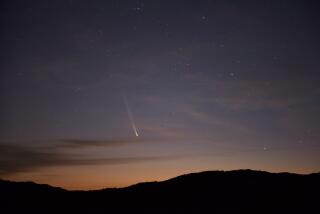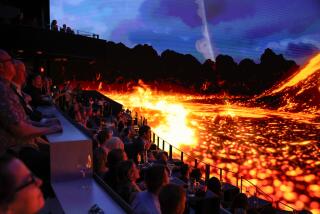Halley’s Playing to Mixed Reviews : Comet Has Become Griffith Observatory’s Star Attraction
- Share via
Joe Siracusa, 19, of North Hollywood popped a dime into a coin-operated telescope on the roof of the Griffith Observatory. He tried to point it almost directly overhead to look at Halley’s Comet, but couldn’t. He settled for pointing it toward the city lights instead.
For perhaps the first time, more visitors to the roof of the Griffith Observatory are scanning the night sky than looking at the twinkling sprawl where the Earth-bound stars live.
Since its Nov. 13 reopening, the roof of the observatory has become a local gathering place, perhaps more social than scientific, for Halley’s comet watchers. Clumps of people stand in frozen poses gazing heavenward, some pointing at the sky.
Celestial onlookers are waiting in line for an hour or more on clear nights between 7 and midnight to catch a free glimpse of Halley’s comet through the observatory’s 12-inch Zeiss telescope. Amateur astronomers are also on hand, setting up their stubby portable telescopes and oversize astronomical binoculars mounted on tripods for public viewing.
According to Anthony Cook of the observatory staff, some comet-struck people have shown more enthusiasm than common sense in their quest to see the interplanetary streak of ice and dust that is coming this way at 25,000 m.p.h. on its 75 1/2-year orbit around the sun.
“We’ve had people come up shaking the rain off them complaining about the telescope not being open,” Cook said. “Well, we can’t see through the clouds.”
Common Misconceptions
He is also surprised by the amount of misunderstanding that surrounds the comet. “Some people are under the impression . . . that it is something that just comes flashing by you for a minute and (then) it’s gone.”
But Cook is devoting considerable energy to educating the suddenly comet-conscious masses. On a recent evening, he bounded in and out of the telescope dome, fidgeting with the telescope adjustment, glowering at clouds that threatened to shroud the star attraction, hailing acquaintances, cajoling bleary-eyed youngsters (“It’s like a big snow cone,” he told one boy) and talking about the comet in short, breathless snatches.
“We’re looking into the tail so we can’t see it,” Cook told one disappointed group of people. “The clouds are reflecting a lot of city light and are making it a hazy, round, small glow.”
Although he said the comet is brighter than experts first predicted, Cook said that perhaps it has been overhyped. “But I’m a bigger sucker for it than anybody. It’s a gut-level reaction you can’t control.”
Indeed. Cook admitted to being a little punchy after staying out until 4 that morning sketching the comet. “The human eye picks up some things that photography can’t,” he said.
Cook said he has watched comets since 1969 and started thinking about Halley’s in 1974 when the much-publicized Comet Kohoutek passed by. “It amazed me how famous Halley’s comet was,” he said. “It is so ingrained in history, some people are surprised how affected they are by it.
“I have been known to sleep in my car and come in the next morning looking bedraggled,” he said.
Asked if the comet’s passing is a high point in his life, Cook paused for a few seconds. “I guess it is,” he said quietly.
He said that most people have been enthusiastic about what they have seen through the observatory’s telescope, even through the views have been less than spectacular. “I think people realize it is still quite a ways out,” he said.
Different Reactions
But for the hundreds of people who saw the comet on a recent evening, the reactions ranged from excitement to mild disappointment.
“It looked like a piece of lint in the sky,” said Martha Mejia, 21, an observatory guide who first saw the comet several nights before with a group of “two-timers”--people who first saw the comet during its 1910 passage.
A similar description came from Luca Gratton, 17, of Hollywood, who came to the observatory with two friends. “It was kind of faint and vague,” he said, shrugging. “I guess it looked like a dot.”
He said he wanted to see the comet “because when it comes back I’ll be dead or real old.”
“I was kind of disappointed,” said Anna Ventriglia, 29, of Los Angeles. “You expect a big star with a long tail.
“But I think I’m witnessing something big. I just want to see the tail.”
Rosa Ruiz, 27, of Hawthorne gave the comet a somewhat better review. “It’s like in a mist with a glow in the middle and it was bluish-greenish. It was a thrill.”
James Anderson, 22, of Arcadia said the image he saw through the observatory telescope “was no big deal,” but hopes to come back to see it again, nevertheless.
“It’ll make a great date,” he said.
Susan Schafenberg, 21, visiting from New Haven, Conn., waxed poetic. “It looked like stardust,” she said.
But where Schafenberg waxed, another tourist, Joyce Newbery, 33, of Belmar, N. J., waned. “This could be the biggest fraud ever perpetrated on the American public. It looked like a small, fuzzy spot, like someone punched a little hole in a piece of cardboard and put a dim light behind it.”
She wasn’t disappointed, however. “Now I can say I saw it.”
‘Two-Timer’
Edith Russ, 89, of San Gabriel saw the comet 75 years ago when she was a girl in Denver.
“My dad used to take us out,” she said. “He thought that was one thing I ought to see.
“We could see it from the yard. It was pretty-good-sized and it had a tail on it.”
Climbing the wooden steps to the telescope with a little difficulty, she said that her father talked about the comet at length, but she didn’t pay much attention back then.
After squinting through the telescope for a minute or so, she gave her verdict on the 1985-86 version of the comet: “It’s smaller than it was 75 years ago.”
Tina Urata, 29, of South Pasadena knocked on the exit door of the telescope dome. Cook popped his head out and Urata made her plea. A couple of seconds later, Cook reappeared, giving her two “first-timer” certificates for her sons, Richard, 2, and Stephen, 9 months. The certificates, given to all children younger than 10 who see the comet from the observatory, double as invitations to come back in 2061 to see the comet’s return.
Just about any view of the comet sounded good to Anna Maria Argumedo, 38, of Los Angeles. Argumedo brought up the rear of the line, which spilled out of the telescope dome and went halfway across the observatory roof. She was on hand to see the comet as an assignment for her microbiology class at Los Angeles Southwest College.
“My grandmother told me it was quite bright and you didn’t need binoculars,” she said. But from the end of the line, she couldn’t even see the telescope.
David Smith, 18, of Westminster was not wowed by the comet, either. “It looked like a little blur, that’s all. But I can tell my grandkids about it. Maybe it will be more interesting then.”
Jose Chavez, 43, of Los Angeles took the philosophical approach. “It makes us realize how small we are in the universe.”
Not all of the comet-watchers at the observatory risked spectator gridlock on the roof. Bill Lindquist, 29, of North Hollywood reclined on the hood of his pickup, back against the windshield, taking a leisurely look through binoculars. “The line’s too long,” he said.
After looking at the comet extensively, he rendered his verdict. “It’s faint and sort of cloudy,” he said, pulling the binoculars back up to his face for yet another look.
More to Read
Sign up for The Wild
We’ll help you find the best places to hike, bike and run, as well as the perfect silent spots for meditation and yoga.
You may occasionally receive promotional content from the Los Angeles Times.






